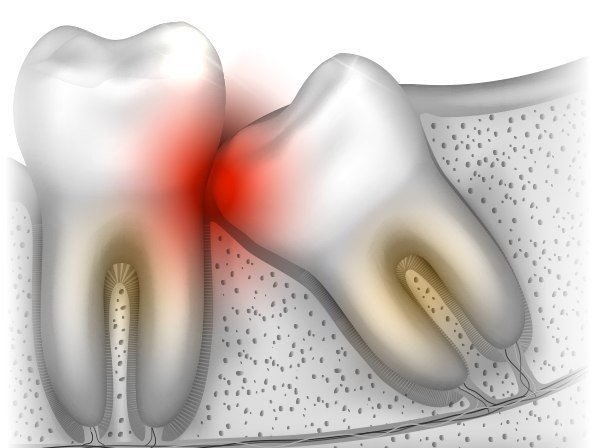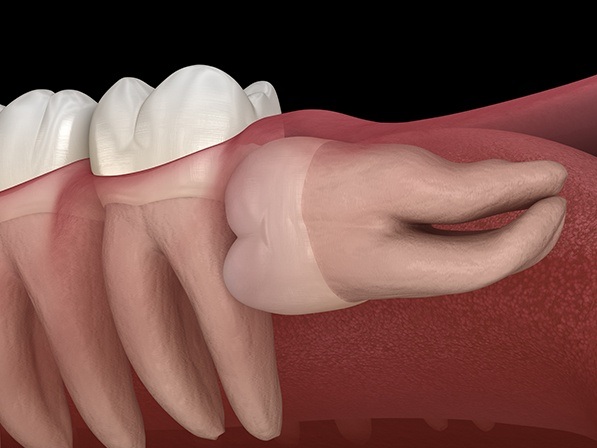Impacted Teeth Treatment – Dallas, TX
Offering Orthodontic & Surgical Solutions
When faced with an impacted tooth, there are methods of treatment used to force or encourage its eruption. While the third molars are typically the most common to become impacted, they’re not the only teeth that can stay put under the gum line and cause oral health problems. In fact, the upper canines, otherwise known as your upper eye teeth, are the second most common impacted teeth. When a patient is experiencing such a problem, the dental professionals at Texas Wisdom Teeth and Dental Implants have various treatment options that can lead to successful alignment and improved oral health, including exposure and bracketing of impacted teeth in Dallas, TX. To learn more about our impacted teeth treatment options, contact us to schedule an appointment today.

Why Choose Texas Wisdom Teeth and Dental Implants for Impacted Teeth Treatment?
- State-of-the-Art Tooth Extraction Techniques
- Interest-Free Dental Financing Options
- Options for Relaxing Sedation Dentistry
What Are Impacted
Canines and Teeth?

If you’ve had your wisdom teeth removed or know someone who has, it may be because they were impacted, which means they lived under the gums and never erupted. While most people believe these are the only teeth that can experience this, the maxillary canines can, too.
The canine teeth are important for your oral health as they play a large role in how you eat as well as how your bite aligns. When these teeth become impacted, it can be due to a few different reasons, including:
- The jaw is too small and there’s not enough room for them to erupt
- Genetics
Any tooth is capable of being impacted, and depending on your child's individual case, the same course of action is taken to encourage eruption.
Diagnosis of Impacted Teeth

When it comes to diagnosing an impacted tooth, it is best if it is addressed sooner rather than later. The older your child gets, the harder it is for the tooth to erupt on its own. There are different methods of determining whether a tooth is impacted and where it is located within the mouth.
- Adult teeth eruption – If teeth are not appearing by a certain time/age, this is a clear indicator that there is a problem.
- Positioning of nearby teeth – We can look at the angle and positioning of the other teeth and determine what position the missing tooth is in.
- Feeling along the gum line – By carefully examining your child’s oral cavity and feeling along the gums, Dr. Anver may be able to feel the position of the tooth.
- X-rays – This is a tried and true method of looking beyond what is visible. An X-ray will show if a tooth is impacted, its position, and how it is affecting nearby teeth. X-rays also provide a blueprint to how our doctors will move forward with treatment.
In the most severe cases, it may be necessary for us to order a CT scan to determine the position of the tooth.
Problems from Impacted Teeth

If you think an impacted canine or impacted teeth isn’t a real issue, you may want to take a look at the various problems that can occur if these scenarios are left untreated:
- Your child will have an incomplete smile – While this may not bother some individuals, most people don’t want to converse or take pictures when a tooth is missing, especially one that is visible to others.
- Possible damage to nearby teeth – Believe it or not, an impacted tooth can actually damage healthy, natural teeth through a process called “resorption.” This occurs when the impacted tooth begins to wear down or “eat away” the normal, adjacent tooth.
- An abnormal growth can develop around the tissue – Known as pathology, this abnormal growth can be in the form of a cyst or tumor. To remedy this situation, the growth would need to be removed as well as the tooth, and in the most severe cases, the patient would lose their adjacent teeth and require surgery to prevent the growth from coming back.
Treatment of Impacted Teeth

In order to expose and bracket an impacted tooth, Dr. Anver will carefully map out a treatment plan to ensure the surgery is successful. Performing a simple, surgical procedure, our team at Texas Wisdom Teeth and Dental Implants will begin by administering anesthesia to ensure your child is comfortable. They will then lift the gum tissue to expose the impacted tooth.
If it is discovered that the baby tooth is still present, it will be removed before an orthodontic bracket is placed onto the permanent, adult tooth. Using a small gold chain, it will be attached to both the bracket and arch wire. This will encourage the tooth to move down into its proper position.
If you’re wondering what happens to the lifted gum tissue, our oral surgeon in Dallas will suture the area and leave the tooth exposed. Over time, the gum will move back into its original position.
Your child will need to visit our oral surgery office over the course of a year so that we can monitor the tooth’s progress. Once the tooth reaches the desired position, we will check the area of the gum to ensure it is healthy and strong.

